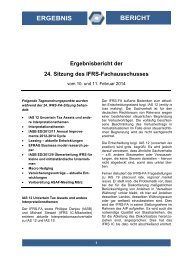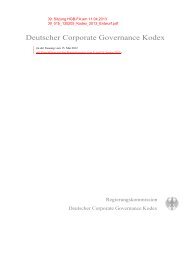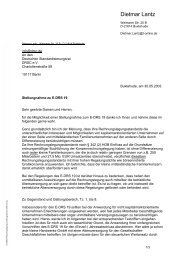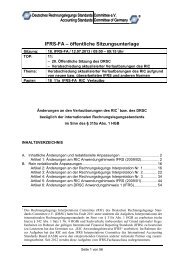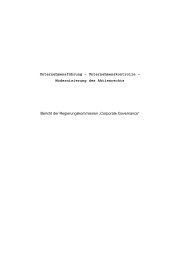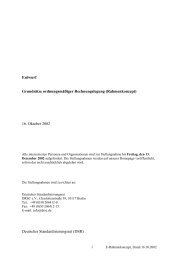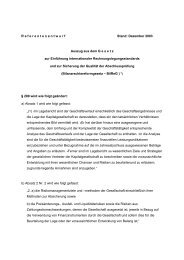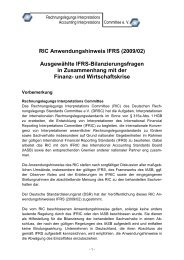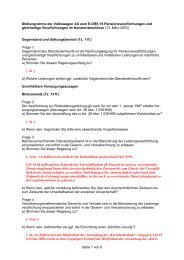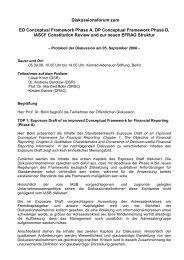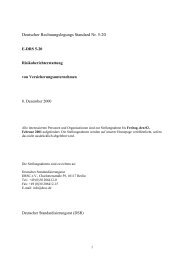Classification and Measurement: Limited Amendments to IFRS 9
Classification and Measurement: Limited Amendments to IFRS 9
Classification and Measurement: Limited Amendments to IFRS 9
Create successful ePaper yourself
Turn your PDF publications into a flip-book with our unique Google optimized e-Paper software.
CLASSIFICATION AND MEASUREMENT: LIMITED AMENDMENTS TO <strong>IFRS</strong> 9 (PROPOSED AMENDMENTS TO <strong>IFRS</strong> 9 (2010))<br />
cost measurement category. 14 Interested parties also indicated that significant<br />
judgement is involved when classifying some portfolios—notably so-called<br />
‘liquidity portfolios’, which are portfolios of assets held by banks <strong>to</strong> satisfy their<br />
actual or potential liquidity needs, often in response <strong>to</strong> regula<strong>to</strong>ry<br />
requirements— as being measured at amortised cost or fair value through profit<br />
or loss, <strong>and</strong> that there may be some inconsistency in the interpretation of<br />
whether the objective of a business model is <strong>to</strong> hold financial assets <strong>to</strong> collect<br />
contractual cash flows.<br />
BC11 In addition, the IASB received views from some interested parties about the need<br />
for a ‘fair value through other comprehensive income’ measurement category.<br />
These views mainly related <strong>to</strong>:<br />
(a) whether measurement at fair value through profit or loss appropriately<br />
reflects the performance of financial assets that are managed both in<br />
order <strong>to</strong> collect contractual cash flows <strong>and</strong> for sale, so as <strong>to</strong> maximise a<br />
return from a combination of contractual cash flows <strong>and</strong> fair value gains.<br />
Some believed that the business model assessment results in<br />
classification outcomes that are <strong>to</strong>o limited, ie an entity either holds<br />
assets <strong>to</strong> collect contractual cash flows, or it is required <strong>to</strong> measure the<br />
financial assets at fair value through profit or loss, <strong>and</strong><br />
(b) the potential accounting mismatch that may arise because of the<br />
interaction between accounting for financial assets in accordance with<br />
<strong>IFRS</strong> 9 <strong>and</strong> the accounting for insurance contracts liabilities under the<br />
Insurance Contracts project. In addition, unlike <strong>IFRS</strong> 9, under the FASB’s<br />
tentative classification <strong>and</strong> measurement model 15 at the start of the joint<br />
deliberations, financial assets were measured at amortised cost, fair<br />
value through other comprehensive income or fair value through profit<br />
or loss.<br />
BC12 Accordingly, the IASB considered whether, depending on the contractual cash<br />
flows characteristics, financial assets should be m<strong>and</strong>a<strong>to</strong>rily measured at fair<br />
value through other comprehensive income on the basis of the business model<br />
within which they are held <strong>and</strong>, if so, what the mechanics of this measurement<br />
category should be. The IASB <strong>and</strong> the FASB also considered the objective of the<br />
business models for measurement at amortised cost, fair value through other<br />
comprehensive income, <strong>and</strong> fair value through profit or loss. The boards also<br />
considered which measurement category should be residual.<br />
14 Paragraph B.4.1.3 of <strong>IFRS</strong> 9 states that if more than an infrequent number of sales are made out of a<br />
portfolio, the entity needs <strong>to</strong> assess whether, <strong>and</strong> if so, how, such sales are consistent with the<br />
objective of collecting contractual cash flows (<strong>and</strong> whether the portfolio would therefore be<br />
measured at amortised cost).<br />
15 One of the stated objectives of these proposals is <strong>to</strong> reduce key differences with the FASB’s model.<br />
Consequently, depending on the context, references <strong>to</strong> the FASB’s ‘tentative classification <strong>and</strong><br />
measurement model’ may refer <strong>to</strong> their model (a) before the joint deliberations (because that<br />
affected the issues deliberated), (b) after the joint deliberations (<strong>to</strong> clarify whether the objective was<br />
achieved), or (c) both (if an aspect of their model did not change as a result of the joint<br />
deliberations).<br />
47<br />
� <strong>IFRS</strong> Foundation



